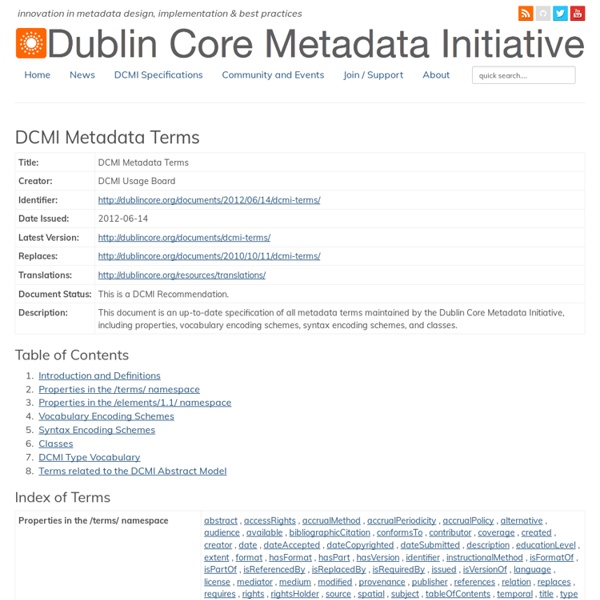DCMI Metadata Terms
Table of Contents Index of Terms Section 1: Introduction and Definitions This document is an up-to-date, authoritative specification of all metadata terms maintained by the Dublin Core Metadata Initiative. Each term is specified with the following minimal set of attributes: Where applicable, the following attributes provide additional information about a term: This release of DCMI Metadata Terms reflects changes described more fully in the document "Maintenance changes to DCMI Metadata Terms" [REVISIONS]. References Section 2: Properties in the /terms/ namespace Section 3: Properties in the /elements/1.1/ namespace Section 4: Vocabulary Encoding Schemes Section 5: Syntax Encoding Schemes Section 6: Classes Section 7: DCMI Type Vocabulary Errata:
Introducing Linked Data And The Semantic Web
Next: Introducing Graph Data What is Linked Data and the Semantic Web and what is all the hype about? Principally, the Semantic Web is a Web 3.0 web technology - a way of linking data between systems or entities that allows for rich, self-describing interrelations of data available across the globe on the web. In essence, it marks a shift in thinking from publishing data in human readable HTML documents to machine readable documents. That means that machines can do a little more of the thinking work for us. How Does It Differ From The Web As It Is Today? Today, much of the data we get from the web is delivered to us in the form of web pages - HTML documents that are linked to each other through the use of hyperlinks. Enter Linked Data - Liberating Web Databases From Their Old Chains The web contains lots of information, but typically the raw data itself isn't available - rather only HTML documents constructed from data, if a web site is generated from a database at all. But Where Do I Start?
RBMS Bibliographic Standards Committee Resources for the Rare Materials Cataloger
General Cataloging Sites Rare Book Cataloging Sites and Resources Library of Congress Lists Reference Sites--General -- Language Resources -- Biography Sites -- Place Names -- Calendars and Computus Special Collections Sites History of Books and Printing Special Topics for Rare Books Images of Rare Books Catalogs which are particularly useful for Special Collections Early Cartographic Materials Medieval Manuscripts Cataloger's Reference Shelf --Includes texts of Marc Formats and Code Lists, LC Subject cataloging Manuals and ancillary manuals such as the Conser Editing Manual and DCRB Internet Library for Librarians Cataloging page --A number of the following sites can also be accessed from this site. MIT Cataloging Oasis Cataloging Tools and Resources--Yale University Princeton Library Cataloging Division Documentation Cataloguer's Toolbox--Memorial University Newfoundland Cornell Tech Services Procedures and Documentation Cornell Voyager Information Cornell Voyager Tables From DCRB to DCRM(B) Refdesk.com
Manual
<div style="text-align: center;"><p><b>RBMS</b></p><p><b>Attention:</b> Your web browser currently has JavaScript disabled or does not support JavaScript,<br/> so this website will NOT function and/or display as intended.</p><p>Please enable Javascript in your browser preferences, or consider using the latest version of <br/><a href=" target="_new">Firefox</a>, <a href=" target="_new">Mozilla</a>, <a href=" target="_new">Netscape</a>, <a href=" target="_new">Internet Explorer</a>, or <a href=" target="_new">Safari</a>.</p></div> Search the RBMS website: Home >> About RBMS >> RBMS Manual Contents RBMS Manual Including revisions approved by the RBMS Executive Committee at the ALA Annual Meeting, June 2002.
Image2DocInfo
Learning 2.0 - 23 Things
Main Page
23 Things Cambridge
The Museums, Libraries & Archives Council
Partners
Europeana partners Europeana could not exist or continue to develop without the help and support of its many partners. The Europeana Network consists of thousands of organisations and institutions from all domains across Europe, from small cultural institutions to large national aggregators, and from data providers to technology solutions. Partners join the Europeana Network for a range of reasons, the key one being knowledge sharing. The challenges of object modelling Semantic and technical interoperability of data Multilingual access Intellectual Property Rights Business models for sustainability. Europeana works with digital library experts, thinkers and practitioners from all over the world in these areas. We always welcome new members to the Europeana Network.Register for the Europeana Network now. View full lists of Europeana's data providers and Europeana Network members here. Aggregators Schematic overview of the Europeana Ecosystem. Type of Aggregators Country Aggregators
World Digital Library Home
Your Old Books
Anyone with an interest in translations of Your Old Books into other languages should contact the current chair of the RBMS Publications Committee. Your Old Books is also available as a compact PDF version. RBMS Publications Committee (Revision 2011) This guide addresses some frequently asked questions about rare and older books and their values. Questions Covered: 1. 2. 3. 4. 5. 6. 7. 8. 9. 10. 11. 12. 13. 14. 15. 16. 17. 18. 19. 20. 21. 22. 23. 1. Millions of books, pamphlets, magazines, newspapers, and broadsides have been published since the invention of printing more than five hundred years ago. 2. People value books either because of their contents or because of their physical characteristics. 3. A book known to exist in only a few copies may have significant monetary value if collectors and libraries prize it. 4. Age by itself is not enough to make a book valuable. 5. 6. Condition refers to a book’s physical appearance and the completeness of its contents. 7. 8. Bibles Encyclopedias
Related:
Related:



